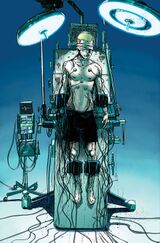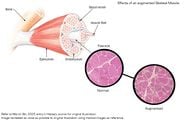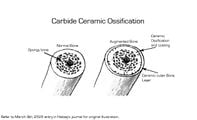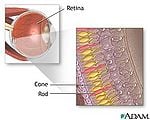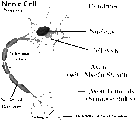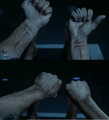Project ASTER: Difference between revisions
From Halopedia, the Halo wiki
m (→Effects) |
|||
| Line 79: | Line 79: | ||
During the [[Battle of Installation 04]], John-117 was able to use his enhanced strength to break the skulls of [[Sangheili]] soldiers.<ref>'''Halo: The Flood''', ''page ??''</ref> During the [[Battle Of Onyx]], Will-043 used his enhanced strength to engage a Hunter pair in hand to hand combat, and succeeded in killing one by ripping the worms out of its body. In the same battle, Kelly-087 engaged three Sangheili in hand-to-hand combat, snapping the wrist of one Elite, taking his energy sword, and cutting three more in half with a single swing. During the [[Battle of Shield 0459]], three Spartan-IIs ([[Jerome-092]], [[Alice-130]], and [[Douglas-042]]), defeated a force of over 20 [[Sangheili Honor Guard]]s in close-quarters combat. | During the [[Battle of Installation 04]], John-117 was able to use his enhanced strength to break the skulls of [[Sangheili]] soldiers.<ref>'''Halo: The Flood''', ''page ??''</ref> During the [[Battle Of Onyx]], Will-043 used his enhanced strength to engage a Hunter pair in hand to hand combat, and succeeded in killing one by ripping the worms out of its body. In the same battle, Kelly-087 engaged three Sangheili in hand-to-hand combat, snapping the wrist of one Elite, taking his energy sword, and cutting three more in half with a single swing. During the [[Battle of Shield 0459]], three Spartan-IIs ([[Jerome-092]], [[Alice-130]], and [[Douglas-042]]), defeated a force of over 20 [[Sangheili Honor Guard]]s in close-quarters combat. | ||
Their reaction time, while impossible to chart accurately, was estimated to be twenty milliseconds. The Spartans' reaction times were noted to be significantly faster in combat situations or with assistance from an AI. The reaction times of the SPARTAN-IIs were so fast that they, in heightened states of stress, were able to think, react and see things as if everything around them were simultaneously occurring at both a slow and rapid pace - a phenomenon dubbed "SPARTAN Time" by Kelly-087.<ref>'''[[Halo: First Strike]]''' ''page 12'' ''page 22'' (definitive edition)</ref> These reflexes allowed [[John-117]] to successfully dodge gunfire during a training exercise when testing the [[MJOLNIR Mark V]]. | Their reaction time, while impossible to chart accurately, was estimated to be twenty milliseconds. The Spartans' reaction times were noted to be significantly faster in combat situations or with assistance from an AI. The reaction times of the SPARTAN-IIs were so fast that they, in heightened states of stress, were able to think, react and see things as if everything around them were simultaneously occurring at both a slow and rapid pace - a phenomenon dubbed "SPARTAN Time" by Kelly-087.<ref>'''[[Halo: First Strike]]''' ''page 12'' ''page 22'' (definitive edition)</ref> These reflexes allowed [[John-117]] to successfully dodge gunfire during a training exercise when testing the [[MJOLNIR Mark V]].{{fact}} | ||
SPARTAN-IIs were also known for their sharp eyesight, their occipital capillary reversal allowing them to virtually see in the dark. | SPARTAN-IIs were also known for their sharp eyesight, their occipital capillary reversal allowing them to virtually see in the dark.{{fact}} | ||
[[Chief Petty Officer]] [[Franklin Mendez]] stated that after the augmentations the SPARTANs would only get better as they adjusted to the changes. Therefore many of the SPARTANs' attributes have increased through time and acclimation. These attributes were completely independent of the MJOLNIR armor, which served to further augment the SPARTANs' unprecedented capabilities. | [[Chief Petty Officer]] [[Franklin Mendez]] stated that after the augmentations the SPARTANs would only get better as they adjusted to the changes. Therefore many of the SPARTANs' attributes have increased through time and acclimation. These attributes were completely independent of the MJOLNIR armor, which served to further augment the SPARTANs' unprecedented capabilities.{{fact}} | ||
Due to the risky and dangerous nature of the augmentation procedures, many of the fourteen year old candidates died or "washed out" as their bodies rejected the modifications being made. Rather than be buried or cremated, the bodies of the deceased were cryogenically preserved with the hopes of one day reviving these candidates.<ref>'''Dr. Halsey's personal journal''' ''April 1st, 2525''</ref> Experimental rehabilitation programs were performed on more then 80% of the washouts, who had suffered varying degrees of disease, injury and deformity. The result of these programs, however, has yet to be determined.<ref>'''Dr. Halsey's personal journal''' ''June 27th, 2525''</ref> The augmentation procedures performed on the SPARTAN-IIs paved the way for [[Project CHRYSANTHEMUM]] and thus "disposable" [[Spartan-III]]s. | Due to the risky and dangerous nature of the augmentation procedures, many of the fourteen year old candidates died or "washed out" as their bodies rejected the modifications being made. Rather than be buried or cremated, the bodies of the deceased were cryogenically preserved with the hopes of one day reviving these candidates.<ref>'''Dr. Halsey's personal journal''' ''April 1st, 2525''</ref> Experimental rehabilitation programs were performed on more then 80% of the washouts, who had suffered varying degrees of disease, injury and deformity. The result of these programs, however, has yet to be determined.<ref>'''Dr. Halsey's personal journal''' ''June 27th, 2525''</ref> The augmentation procedures performed on the SPARTAN-IIs paved the way for [[Project CHRYSANTHEMUM]] and thus "disposable" [[Spartan-III]]s. | ||
Revision as of 07:26, December 9, 2012
- "...the white coats coming at you with their needles and knives, their kind and serious voices. Their heartfelt belief that it's all for a good cause."
- — Melissa[1]
The SPARTAN-II augmentation procedures were a series of biochemical and bio-mechanical manipulations applied to SPARTAN-II conscripts at the onset of puberty.
History
Human biochemical experiments and enhancement procedures have been a part of society dating back to the 20th Century; their gains have attracted widespread attention in the hopes of improving human strength and endurance. Military experimentation with such enhancements has always been limited for the sake of moral and ethical concerns. However, as technology improved and as scientists continued to understand the human body, advancements paved the way for the eventual use of body enhancement chemicals — the first bio-engineering protocol was established to help humans adjust to long duration spaceflight and different planetary environmental conditions, and subsequently for interplanetary war.[2] The fruition of such procedures to help create a superior soldier did not solidify until the limited success of the ORION Project, which would pave the way for the success of the SPARTAN-II Program.
Research on the then-named ORION Generation II augmentations began five years after the deactivation of the ORION Project.[3] Early analysis concluded that next-generation candidates must have "more malleable, robust DNA structure and repair enzymes," this being based on the fundamental flaw of the augmentation procedures performed on the ORION soldiers. Because of the requirements, the best suitable candidates who would adapt without severe side effects were those of prepubescent age.
Candidates of prepubescent age were screened based on genetic markers/SNPs that are linked to positive fitness and decreased disease incidence. The task of screening for such DNA structures was astronomical and to properly screen for correct genetic markers would require thirty-nine billion records.[3]
In the initial studies and research conducted on possible procedures, two of the proposed augmentations were rejected because of their risks and drawbacks, the first being adrenal-response enhancement, which would enhance the autonomic nervous system to better balance between sympathetic and parasympathetic function in the body's response to stress.[4] The next was memory and cognitive enhancements; these were rejected based upon the mental instabilities that could occur.[4] From 2511 until the augmentation of the SPARTAN-IIs in 2525, research continued refining and improving the chemicals to reduce failure rate. Later research proved difficult for other mental, adrenal and neural enhancement procedures to be used on the SPARTAN-IIs because of their unacceptable failure rates.[5] Admiral Ysionris Jeromi conducted experimental procedures on bonobo chimpanzees at the request of his former student in an attempt to help reduce the failure rates and improve the regime.[6]
Augmentations
Chemical augmentations work on a molecular level by targeting molecules within the body and then altering them to begin a growth process of targeted tissues. Although the chemicals work on a molecular level, they do not work on a genetic level, as targeted mutagenesis is impossible only with chemicals.
The process of augmenting the SPARTAN-IIs was divided into two parts, surgical procedures and injection procedures. Surgeries were highly risky, intensive, and required special medical talent. Their safety and effects varied substantially from subject to subject, with the benefits and risks varying with the surgeon, the surgical conditions, and the state of the patient.[7] Chemical augmentations have their own risks dependent upon the subject's genetic background and how they adjust to the alteration of cells and molecules and to a more physical point, tissue growth.
| Procedure | Description | Risk(s) |
|---|---|---|
| Occipital Capillary Reversal | Surgery is performed on the occipital lobe of the left cerebral hemisphere of the brain; the occipital lobe is the visual processing center of the brain, containing most of the anatomical region of the visual cortex. The surgeon performs a procedure on the capillaries, the smallest of the body's blood vessels, to reverse the direction of blood flow in each capillary to boost the blood flow beneath the rods and cones of the subject's retina. The rods and cones of the eye are light-sensitive receptors located in the back of the eye. Together they are able to detect movement, light and color, and relay that information back to the brain. This procedure produces a marked visual perception increase.[6] | 11% of subjects could face retinal rejection and detachment causing permanent blindness.[6][5] |
| Carbide Ceramic Ossification | Surgery is performed on the arms and legs of the subject's body to expose the bone. An advanced carbide ceramic material is grafted onto the skeletal structure to begin skeletal ossification. This process works by breaking down bone and rebuilding it stronger then before. This results in the bones being virtually unbreakable. The coverage of this procedure does not exceed 3% total bone mass due to significant white blood cell necrosis; to make up for that a growth hormone is administered to help strengthen the bones throughout the rest of the body.[6] | 3.8% failure rate due to possible mutations and compromised bone marrow matrix integrity. In pre-and near-postpubescent adolescents, skeletal growth spurts may cause irreparable bone pulverization.[6][5] |
| Catalytic Thyroid Implant | A platinum pellet is implanted in the left thyroid gland; this pellet contains a human growth hormone that is released into the body to boost growth of skeletal and muscle tissues. As the hormone is released into the body the pellet dissolves and is absorbed. The hormone targets and stimulates the growth of fast and slow twitch muscle fibers, effectively producing significant gains in muscle mass. The hormone also targets osteoblasts to help boost bone tissue formation and effectively strengthen the bone structure.[6] | 2% of subjects acquire elephantiasis. Suppressed sexual drive.[6][5] |
| Muscular Enhancement Injections | In addition to the growth hormone catalyst, a protein complex is injected intramuscularly that targets the muscles' intracellular molecular machinery to help increase muscle strength and endurance. These injections target the muscles' molecules increasing the density of the connective tissues and fibers, the more visible result being the muscles quivering and contorting over one another, making connecting tendons stronger and decreasing lactase recovery time.[6][5][8] | 5% of test subjects experience a fatal cardiac volume increase.[6][5] |
| Superconducting Fibrification of Neural Dendrites | Alteration of bioeletrical nerve transduction to shielded electronic transduction. 300% increase in subject reflexes. Anecdotal evidence of marked increase in intelligence, memory, and creativity.[6] | 12% of subjects can contract Parkinson's Disease and Fletcher's Syndrome.[6][5] |
Procedure
To prepare the subject for the augmentation procedure, the subject's head is shaved and incision vectors are lasered onto the subject's body. An intravenous drip is inserted into the subject's arm, and a general anesthetic is administered to ease the subject into a state of unconsciousness. Once the subject has been sedated, he or she is transported from the pre-op wing of the facility to another area, where the surgical procedures are performed.[9]
The first procedure most likely performed is the occipital capillary reversal.[7] A neurosurgeon cuts out a small space in the skull, exposing the brain. The neurosurgeon then performs a procedure to rearrange the capillaries in the occipital lobe of the left cerebral hemisphere of the brain. This redistribution of blood vessels boosts the flow of blood beneath the rods and cones of the subject's retina. Once the surgery is complete, the piece of the subject's skull that was removed in order to access the occipital lobe is repaired and the subject's head is bandaged.Template:Fact
The catalytic thyroid implant is likely the next procedure. Surgery is performed on the thyroid gland, where an incision is made to the left thyroid gland large enough for a platinum pellet to be implanted; once done, the incision made is closed up. The growth hormone is released and progressively works its way through the body, stimulating the growth of skeletal and muscle tissue.[10][7]
As this takes place, muscular enhancement injections are administered throughout the subject's body to aid the previous procedure. This produces the most prolonged delay in the rest of the augmentation procedures as the subject's body begins to alter as a result of the previous procedure. If the subject has survived the changes, the final part of the augmentation is performed.[10][7]
The carbide ceramic ossification is likely performed next. This involves applying a grafting material to the subject's bones in key areas, most likely via injections. The process involves laying down new bone material with cells called osteoblasts to strengthen the bone. Once completed, the ossification continues while other procedures are performed.[7][11]
Once the augmentation procedures are finished, the subject begins a long recovery process. The healing process takes anywhere from weeks to months, dependent upon each individual subject's rate of recovery. Every day the subject performs stretches, isometric exercises, light sparring drills and consumes five high-protein meals. After each meal, the subject must report to the medical bay to receive a series of vitamin and mineral injections.[12]
Effects
Although the subject is in a state of unconsciousness during the procedure, he or she may experience excruciating pain. Physiological stress brought on by the augmentations can produce cardiac arrest,[5] in addition to cross-chemical complications that can result in augmentation failure.Template:Fact
Each procedure is marked by a particular type of excruciating pain. The carbide ceramic ossification is said to feel like the subject's bones are breaking, and as if their marrow is made of glass and is being shattered.[11][13] The catalytic thyroid implant and muscular enhancement injections produce extraordinary pain, as if the subject's veins had been "injected with napalm";[13][8] another sensation is pulsating and the feeling of the veins being torn out of the subject's skin. The effect of the muscles increasing in density is said to feel like the entire body is on fire, mixed with the feeling of "plated glass shattering" and being worked in the subject's body.[8] The superconducting fabrication of neural dendrites is said to feel like fire burning along the subject's spinal nerves.[11]
The side effects of completing the augmentations vary, as the subject's brain relearns how to move his or her body with faster reflexes and stronger muscles. The subject may experience neurological confusion such as falling over, exaggerated reflexes, and problems grabbing or holding onto an object. The subject may experience bleeding from the eyes, constant headaches, and aches in the bones.[14]
As time goes on, successful augmentation subjects' side effects diminish either completely or to the point where they are considered mild.Template:Fact
Results
Only a few months after augmentation procedures, the SPARTAN-IIs were capable of running at speeds exceeding 55 km/h or 34.2 mph. Kelly-087 was noted as capable of running even faster. Later during the Human-Covenant war, while in her Mark V MJOLNIR Armor, Kelly-087's top speed was 62 km/h or 38.5 mph.[15] John-117 has been noted to have, briefly, run at around 105 km/h or 65.2 mph during a MJOLNIR Mark V training exercise; however, his Achilles tendon was torn because the strain put on his body was unsustainable.[16]
The SPARTAN-IIs were capable of lifting at least three times their body weight without the aid of their MJOLNIR Powered Assault Armor. John-117 once used a combination of his enhanced strength and MJOLNIR armor to kill a Brute with his bare hands during Operation: FIRST STRIKE.[17] Cal-141 was capable of blocking a Jiralhanae Chieftain's Gravity Hammer swing with a single hand, dodging multiple swings from the Chieftain, using her enhanced muscle strength to jump to great heights, and wounding the Chieftain with a few punches and kicks; all with her armor as well.[18]
During the Battle of Installation 04, John-117 was able to use his enhanced strength to break the skulls of Sangheili soldiers.[19] During the Battle Of Onyx, Will-043 used his enhanced strength to engage a Hunter pair in hand to hand combat, and succeeded in killing one by ripping the worms out of its body. In the same battle, Kelly-087 engaged three Sangheili in hand-to-hand combat, snapping the wrist of one Elite, taking his energy sword, and cutting three more in half with a single swing. During the Battle of Shield 0459, three Spartan-IIs (Jerome-092, Alice-130, and Douglas-042), defeated a force of over 20 Sangheili Honor Guards in close-quarters combat.
Their reaction time, while impossible to chart accurately, was estimated to be twenty milliseconds. The Spartans' reaction times were noted to be significantly faster in combat situations or with assistance from an AI. The reaction times of the SPARTAN-IIs were so fast that they, in heightened states of stress, were able to think, react and see things as if everything around them were simultaneously occurring at both a slow and rapid pace - a phenomenon dubbed "SPARTAN Time" by Kelly-087.[20] These reflexes allowed John-117 to successfully dodge gunfire during a training exercise when testing the MJOLNIR Mark V.Template:Fact
SPARTAN-IIs were also known for their sharp eyesight, their occipital capillary reversal allowing them to virtually see in the dark.Template:Fact
Chief Petty Officer Franklin Mendez stated that after the augmentations the SPARTANs would only get better as they adjusted to the changes. Therefore many of the SPARTANs' attributes have increased through time and acclimation. These attributes were completely independent of the MJOLNIR armor, which served to further augment the SPARTANs' unprecedented capabilities.Template:Fact
Due to the risky and dangerous nature of the augmentation procedures, many of the fourteen year old candidates died or "washed out" as their bodies rejected the modifications being made. Rather than be buried or cremated, the bodies of the deceased were cryogenically preserved with the hopes of one day reviving these candidates.[21] Experimental rehabilitation programs were performed on more then 80% of the washouts, who had suffered varying degrees of disease, injury and deformity. The result of these programs, however, has yet to be determined.[22] The augmentation procedures performed on the SPARTAN-IIs paved the way for Project CHRYSANTHEMUM and thus "disposable" Spartan-IIIs.
Gallery
Detail of the surgical augmentations performed on the forearms of a SPARTAN-II, in this case John-117.
Sources
- ^ Phase 2 Operator's Monologue, i love bees
- ^ Halo Encyclopedia, page 44
- ^ a b Dr. Halsey's personal journal February 15, 2511
- ^ a b Dr. Halsey's personal journal December 4th, 2510
- ^ a b c d e f g h Dr. Halsey's personal journal March 9th, 2525
- ^ a b c d e f g h i j k Halo: The Fall of Reach, page 57 (2001 edition) page 62-64 (definitive edition) page 74 2010 edition
- ^ a b c d e Halo: Evolutions - Essential Tales of the Halo Universe Pariah page 32
- ^ a b c Halo: Evolutions - Essential Tales of the Halo Universe Pariah page 34
- ^ Halo: The Fall of Reach page 59 (2001 edition) page 66 (definitive edition) page 77 (2010 edition)
- ^ a b Halo: Evolutions - Essential Tales of the Halo Universe Pariah page 39
- ^ a b c Halo: Ghosts of Onyx, page 63
- ^ Halo: The Fall of Reach, page 64(2001 edition) page 71 (definitive edition) page 82 (2010 edition)
- ^ a b Halo: Ghosts of Onyx, page 101-102
- ^ Halo: Fall of Reach, page 62 (2001 edition) page 69 (definitive edition) page 80 (2010 edition)
- ^ Halo: Ghosts of Onyx, page 168
- ^ Halo: The Fall of Reach, page 264 (2001 edition) page 305 (definitive edition) page 299 (2010 edition)
- ^ Halo: First Strike, page 313 (2003 edition)
- ^ Halo Legends The Babysitter
- ^ Halo: The Flood, page ??
- ^ Halo: First Strike page 12 page 22 (definitive edition)
- ^ Dr. Halsey's personal journal April 1st, 2525
- ^ Dr. Halsey's personal journal June 27th, 2525
List of appearances
- Halo: The Fall of Reach (First appearance)
- Halo: Ghosts of Onyx
- Halo: Evolutions - Essential Tales of the Halo Universe
- Halo: Fall of Reach - Boot Camp
- Halo Legends
- Scanned
- Halo 4
See also
| |||||||||||||||||
